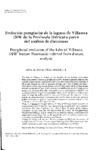Evolución postglaciar de la laguna de Villaseca (NW de la Península Ibérica) a partir del análisis de diatomeas

Ver/
Use este enlace para citar
http://hdl.handle.net/2183/6277Coleccións
Metadatos
Mostrar o rexistro completo do ítemTítulo
Evolución postglaciar de la laguna de Villaseca (NW de la Península Ibérica) a partir del análisis de diatomeasTítulo(s) alternativo(s)
Postglacial evolution of the Lake of Villaseca (NW Iberian Peninsula) inferred from diatom analysisData
1997Cita bibliográfica
Cadernos do Laboratorio Xeolóxico de Laxe, 1997, 22: 81-97 ISSN: 0213-4497
Resumo
[Abstract] The lake of Villaseca is located in the foothills of the southern Cantabrian Mountains, nearby Villaseca de Laciana (León,NWIberian Peninsula). This lake has a glacier origin and has been formed due to the obstruction of a lateral moraine of the glacier tongue that will be canalized through the Valley of Brañas de Roble. Once discovered during the Late Glacial (over 23,000 years), the linle basin beganto work as a catchment area. A 893 cm length record has been srudied. Ir shows the postglacial evolution of the lake. Most part of this record (beteween 260-893 cm) is represented by a detritic varved sedimentation, where the absence of diatoms is clear, although the pollen record is continous all through the sequence. In this period, the paleolimnological reconstruction can't be done, because the grains of pollen in the sediment proceed from an alloctonous source and they only reflect the landscape in the surroundings of the lake. With the begining of the Late Glacial the lake of Villaseca began to present an autoctonous diatom flora and the basin changed to mesotrophic and slightly alkaline conditions. The most important data proceed from the study of the diatoms succession, which points out and environment dominated by tychoplanktonic Fragilaria assemblages, only interrupted by a period ofperiphytic, acidophilous and oligotrophic assemblages. During this episode the pollen record points out a stepic vegetation, represented by Artemisia and Poaceae. During the Postglacial, the basin becomes completely filled and the number of acidophilous taxa increase. This is a typical final step of the filling process ofa lake before transforming into a bog as the presence of Sphagnum establishes.
Palabras chave
Paleolimnology
Diatoms
Late Glacial
NW Iberian Peninsula
Diatoms
Late Glacial
NW Iberian Peninsula
ISSN
0213-4497





